Sgt B Bailey and L/Cpl S Cooper of the British Indian Provost Company have their trousers repaired by an Indian member of the company, working with a sewing machine in the open, Italy, 9 March 1944.
More MilFashion to come…
…-
Sgt B Bailey and L/Cpl S Cooper of the British Indian Provost Company have their trousers repaired by an Indian member of the company, working with a sewing machine in the open, Italy, 9 March 1944.
More MilFashion to come…
…-
QM Fashion was created as a project for my Senior Marketing Management course #cc410mkt taught by Professor Elaine Young, a Social Media Marketing Guru at Champlain College in Burlington, Vermont.
However, the idea for QM Fashion has been living in my head ever since I saw a photograph of famous designer Ralph Lauren wearing a rare and original WWII American M-1942 Paratrooper Jacket in a fashion magazine at the dentist office (there were no other magazines available mind you). I saw the photo and I realized that the uniforms and the equipment that I grew up loving and collecting were in fact popular with an entirely different community of people, aside from “nerdy” collectors and reenactors that I had grown to love. These two distinctly different groups of people, fashionisatas and military collectors/reenactors, both sought after and purchased the same uniform pieces, but bought them in different ways and for different prices.
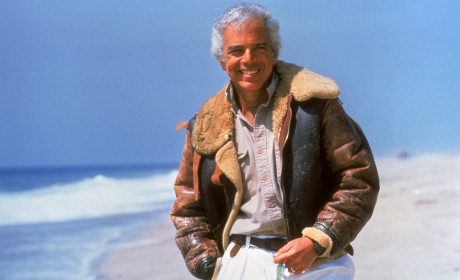 Ralph Lauren wearing an original WWII Bomber’s Jacket
Ralph Lauren wearing an original WWII Bomber’s Jacket
*This is not the photo I saw, but this is a good example of his affinity for WWII uniforms.
With this knowledge in hand things started appearing to me in my daily missions, from Montreal to Paris. All of a sudden, I was seeing the same types of jackets and boots I had seen on living historians at reenactment weekends on Parisans/Montrealers going about their daily lives. No one was calling this phenomenon out or even acknowledged what was happening in either communities. I hope to do just that through my blog QM Fashion.
In regards to the social media aspect of QM Fashion, it has been a true eye opener. I have learned a lot about how Twitter and Facebook can truly make or break a blog and how if used effectively, can compliment it nicely. Amongst Twitter and Facebook, another key aspect for drawing visitors to QM Fashion has been Search Engine Optimization (SEO) on Google. In the world of history, and especially military history, there are so many key words that people search for, especially of images that continue to bring visitors to my blog. I have learned the importance of naming everything, from links to photos, to increase my ranking on Google with SEO. By using the same SEO date information used for QM Fashion, I can further promote my family’s military store’s website. The two projects will eventually be further developed and compliment each other.
Being active is the most important thing to remember about social media, especially for businesses. Consistently updating Twitter, Facebook, and your blog is essential and what it really comes down to is creating content. The more content created, the more there is to offer a visitor and the more for a search engine to catalog. Being pro-active with Twitter and other blogs is a must; commenting and replying with these two social media tools is essential for being “found.” Reaching out to people via these tools creates a connection, one that is observable to each of your connections and also to the public. These connections beget more connections. The observable connections and interactions create hype and publicity, which both draws more visitors to see your blog or website.
Overall this experience has shown me that these connections can lead you to some pretty interesting people and opportunities. A few tangible examples of these connections are some excellent exchanges with fellow bloggers and an army surplus store requesting to be featured in my blog. These examples are showcased below.
A fellow Blogger, @nostalgicabe, and I had an excellent interaction on the subject of classic vintage WWII boots.
Another blogger, @driftingfocus, who is a photographer and reenactor blogger found my blog and my Twitter and we are planning on doing an interview soon for her reenacting blog.
An army surplus store, @army_surplus “Denbigh Army Surplus ltd”, in North Wales, United Kingdom, requested to have a product of theirs featured in my blog in response to the post on military caps. In the United Kingdom! do you believe that? That’s an excellent example of how far reaching these social media tools are. I have initiated contact with them and I would be happy to do a feature for them.
Shown below is the effect of SEO in action through key military/fashion related words.
QM Fashion’s Key Words above
There is a clear correlation between keywords and the top posts.
The amount of visitors to the blog has grown exponentially and continues to increase with each and every post, (content creation). Between the three social media tools I utilize to promote my blog, I would say the most successful is Facebook and SEO keywords on Google. Twitter plays more of a role in identifying the types of people that actually visit the blog, but the majority of visitors are routed through either Google with search words, my personal Facebook or T.F. Quilty Co.’s Facebook Business Page.
Before beginning the QM Fashion blog project, my goals for the end of the semester were:
MAY. 7. 2011-
1. Total of 75 Blog Posts (This is my 21st Blog Post)
2. Total of 100 Twitter Followers (90 @AlexQMFashion Followers)
3. 20 WordPress subscribers ( 4 Subscribers, only two I didn’t know)
4. Website Created and fully operational (T.F. Quilty Co.’s Website is 75% operational)
5. 100 Likes on the QM Fashion Facebook Page (224 Likes on WWIIQM)
As you can see, not every single goal was accomplished, but I came awfully close to just about every one. I would have to say that before beginning this project, I was overly optimistic about how much content I could actually produce. This may have been the most important lesson I have taken away from this project, knowing my abilities. Creating content is one thing, but creating quality content takes time and I have learned that in blogging, quality content can make all of the difference. I believe though that I have worked hard and achieved what I set out to do in creating a personal brand. I took my passion and built a brand around it.
 The Top Referring Websites are featured above.
The Top Referring Websites are featured above.
Consistently there are about 500 visitors per week.
I will continue to blog and my intentions for QM Fashion is for it to become another department of T.F. Quilty Company, my family’s Army Navy Surplus business in Chicago, IL. T.F. Quilty Co. currently sells vintage military items, but eventually I believe there is an opportunity to venture into the fashion industry, and creating a buzz for military fashion will be yet another one of the many functions of the QM Fashion blog.
What QM Fashion has taught me as a newcomer blogger and Twitterer, is the true power and influence of social media in regards to promotion and getting information to the public. That being said, you need to have the content to support the promotion and I believe that my niche of military fashion is specialized enough to offer some pretty insightful content to visitors. The project has provided me with an excellent blog and outlet for showcasing my daily military fashion finds. I know that if I keep on my toes when it comes to updates and developments in social media tools and services, I can develop QM Fashion into a reputable fashion resource and a successful referrer website to my family’s business website, T.F. Quilty Co.
I hope to continue providing my visitors with new and insightful content for as long as I can still see shades of green and military style pockets in the fashion magazines, runways and on the streets of Paris and New York.
 Never fear! I will continue practicing safe blogging here at T.F. Quilty Co.‘s QM Fashion!
Never fear! I will continue practicing safe blogging here at T.F. Quilty Co.‘s QM Fashion!
…-
One of the most prevalent military inspired fashion design feature in the jackets and pants of today, are utility cargo pockets. Originally introduced in the 1990’s as a fashion hit and now a subtle accepted practice. Literally on every street, in every magazine and on every runway, there are military style cargo pockets. The cargo pocket pants or trousers really sparked this entire trend. The history of the cargo pants is one that includes a World War and consistent combat experiences on six continents, spanning almost 70 years.
The first cargo pants were introduced by the British Army in 1938 on their wool battledress uniforms as the United Kingdom was preparing for war with Nazi Germany. However, the British military only placed a single cargo pocket on the left leg of the trousers, this was in the form of a patch type pocket and was not bellowed out. This patch pocket was not all that practical for British soldiers and in fact, British Parachutists during the war were issued special leather lined bellowed cargo pocket trousers. This was similar to the original design, with only a single pocket on the left leg above the knee, facing outwards towards the soldier’s front.
 The first “Cargo Pants” on the WWII British P-37 Battle Dress Uniform. *Notice the single patch pocket facing front.
The first “Cargo Pants” on the WWII British P-37 Battle Dress Uniform. *Notice the single patch pocket facing front.
The British may have created and issued the first cargo pocket pants, but the cargo pants that the modern military and fashion world know today were inspired by the United States. The American military’s first issue of cargo pockets occurred early in World War Two, with the specialized M-1942 Paratrooper uniform. The M-1942 Paratrooper cargo pants differed from the British trousers as the pockets were placed on the sides of the trousers and also their were two instead of one. Before this specialized uniform, the American military only issued and fielded all wool shirts and trousers uniforms with a cotton windproof jacket known as the M-1941 Jacket or Parsons Jacket. This would remain as the standard uniform for the majority of the war until the adoption of the M-1943 Uniform late in the war. The M-1943 Uniform would include cargo pockets on the jacket, but cargo pockets on the trousers would not take place till shortly before the Korean War.
An original color photograph from WWII showing the complete M-1942 Paratrooper uniform alongside a set of “What Price Glory” made reproduction trousers.
The M-1942 Paratrooper Uniform was a success and soon after, the United States military began to add cargo pockets to a host of other combat uniforms, including their durable cotton Herringbone Twill (HBT) uniforms. HBT uniforms were originally designed for hard labor or as work uniforms, but soon became the preferred uniform for American soldiers to wear during spring and summer combat. By the end of WWII the American military realized that the future for combat uniform trousers was in cargo pockets.
The Korean War saw the introduction of the M-1951 uniform trousers that also had cargo pockets and these were issued to every soldier. During the Vietnam War, a lighter version of the M-1951 trousers was implemented, over the course of the war these would go through two pattern changes. The Vietnam War is where the cargo pockets really earned their reputation for being completely necessary and practical. During this conflict, the American soldier was now carrying more equipment and gear then they had ever before and this would not have been possible without cargo pants.
After the Vietnam War, there were a few modifications to the American military cargo pants, the most significant being the introduction of camouflage, but for the most part the design stayed the same. The basics were the same with two large cargo pockets on the side of durable cotton “rip-stop” trousers with leg ties at the end of the trousers to assist in blousing boots. The most up to date version of American military cargo pants are the digital camouflage Army Combat Uniform trousers, which are seeing action in Iraq and Afghanistan today.
The evolution of the Modern Cargo Trousers.
 The progression from “At The Front” made WWII HBT trousers to the M-1951 trousers to the 1st Pattern Jungle trousers to the last pattern of jungle trousers issued during the Vietnam War.
The progression from “At The Front” made WWII HBT trousers to the M-1951 trousers to the 1st Pattern Jungle trousers to the last pattern of jungle trousers issued during the Vietnam War.
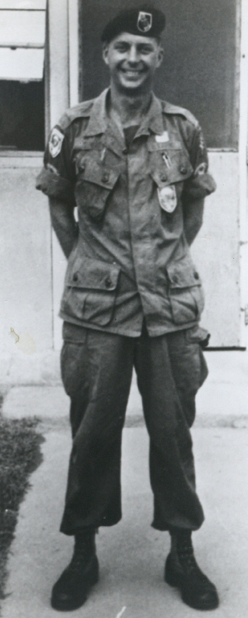 An American Soldier wearing Cargo Pants during the Vietnam War.
An American Soldier wearing Cargo Pants during the Vietnam War.
 Modern “Cargo Pants” are still being issued to American Soldiers with the Army Combat Uniform (ACUs)
Modern “Cargo Pants” are still being issued to American Soldiers with the Army Combat Uniform (ACUs)
The fashion world was taken by storm in the 1990’s by these rough cargo pants and it was all due to the “trickle up” fashion theory on how trends and styles spread. The “trickle up” theory occurs when fashion from the streCargo pants became popular starting with the hip-hop artists wearing old surplus military cargo pants, and that’s all it took for the fashion world to go gaga for cargo pants!
Because there are so many designers and fashion houses that have adopted cargo pockets in their pieces and lines, I am only featuring a few examples below.
Rag & Bone Carps Cargo Pants $285.00
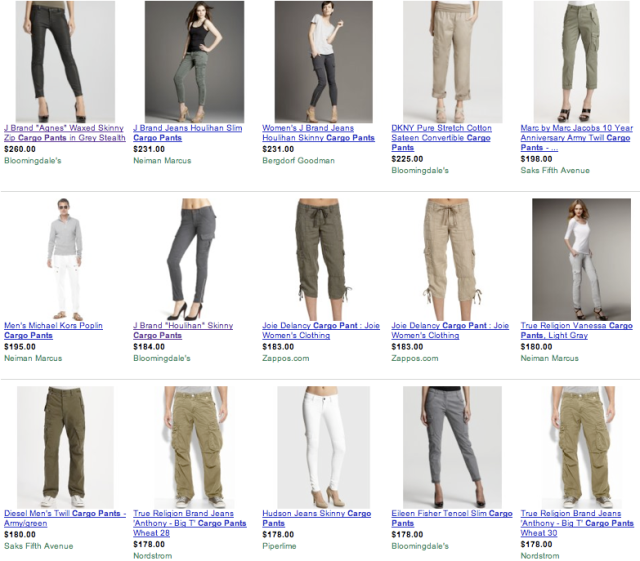 A Google Search Result for Cargo Pants
A Google Search Result for Cargo Pants
The trend like many things from the 90’s did eventually fizzle out. However, this trend does live on. In modern day fashion, cargo pockets keep making an appearance, and in most cases they are for pure decoration and serve no actual utility on jackets and pants. The cargo pants are here to stay and it was all due to some innovative military minds who needed a cheap way to have soldiers carry more ammunition and equipment.
The practicality of Cargo Pants is not going away any time soon, especially in regards to its place in the fahsion world. One of the most popular features of military inspired fashion, is the durability and practicality that is found in military uniforms and equipment, just as the military fashion trend continues, so will cargo pants.
Cargo Pants are here to stay, if not to carry grenades or rations, to carry our modern day cellphones and Kindles.
…-
Now that we’ve opened up the paratrooper fashion trunk the next special airborne uniform piece that has made the list is the infamous “Jump Boots.”
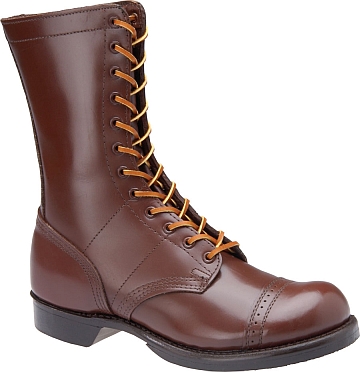 Corcoran American Paratrooper “Jump” Boots
Corcoran American Paratrooper “Jump” Boots
The United States’ Airborne Soldiers were one of the most specialized group of individuals during World War Two and were equipped and uniformed as such. Their overall combat uniform was the M-1942 Paratrooper Uniform, which consisted of the M42 Jump Jacket and the first combat cargo trousers issued in the 20th century. The uniform would not have been complete without a nice shiny pair of boots to go with it.
 The M-1942 Paratrooper Uniform worn w/ “Jump” Boots
The M-1942 Paratrooper Uniform worn w/ “Jump” Boots
One of the primary reasons why paratroopers were issued specialized uniforms was due to the nature of their missions. Airborne units would be expected to sustain themselves and fight behind enemy lines for days on end. The cargo pockets on their uniform were needed for extra equipment and ammunition. Their boots however were designed to give extra ankle support for rough parachute landings. They were designed by Lieutenant Colonel Yarborough who also designed the actual Parachutists Jump Wings, the M-1942 Uniform and also various other parachute delivery equipment.
 American Paratrooper with standard equipment load boarding a C-47 for D-Day, June 6th 1944
American Paratrooper with standard equipment load boarding a C-47 for D-Day, June 6th 1944
The boots would cause ripples across military history and most recently in the world of fashion. The boots were unique in the sense that they were calf length and completely leather. The reason why this was so unique was that up until this point, American soldiers and the majority of soldiers in the world, were issued low-quarter or ankle boots with some type of wool wrap or canvas leggings/gaiters. This measure was implemented because the low quarter boots needed to be worn with their dress uniform and also in combat. This division of combat uniforms and dress/formal uniforms is covered in further detail in an earlier post.
The actual paratrooper boots became a symbol of the airborne soldiers and were highly sought after by other non-airborne soldiers. Even today in the airborne community and often heard at the United States Jump School a “leg” is a normal or regular soldier. The term originated in WWII and was originally “Straight leg” and this referred to the lack of bloused trousers on non-airborne soldiers. This perpetuated the symbolism of the Jump boots because paratroopers bloused their trousers into their boots. The act of blousing their boots and their M-1942 Paratrooper Cargo Trousers led to German soldiers famously nicknaming Paratroopers “those devils in baggy pants.” They were so desired that during the war, non-airborne Soldiers would just about trade anything to get ahold of a pair. This would also cause some fights between real paratroopers and those who would wear them on leave or furlough. A hot set of boots as you can see!
The boots themselves were eventually replaced by the “Double Buckle” M-1943 Combat Boots beginning in 1944, around the time of Operation Market Garden in Holland. Many paratroopers retained their jump boots and continued to wear them until the end of the war and during the early years of Germany and Japan’s occupation. Although the American military had converted to the “Double Buckle” boots at the end of the war, the popularity and durability of the Jump Boots was hard to ignore and eventually a version of them were issued to all soldiers in the Korean War and in the early stages of the Vietnam War. The boots themselves have gone through various configurations and they have been one of the many models of boots that have been the “boots on the ground” for every American conflict since WWII up until modern day.
Their popularity and transition can be seen in the photographs below.
The WWII Version compared to the Vietnam War era version and Modern Dress Uniform Version.
The Tactical Jungle Version & The Desert Tan Version of the Jump Boots.
 The U.S. Air Force Battle Uniform (ABU) Version Jump Boots
The U.S. Air Force Battle Uniform (ABU) Version Jump Boots
All the versions of the boots showcased above can be found online at ShoeLine
Fashion has taken the signature Paratrooper “Jump” boots design features, such as the toecap, the reinforced ankle and its rugged sole, and incorporated them into some classic and vintage designs.
All Saints Military Boots $299.00 Vintage Shoe Co. Molly Tan Boots $295.00
All Saints Military Boots (White) £110.00 Dirty Laundry Lois Boots $79.99
The boots have become quite popular and can be seen worn in their original reproduction versions from WWII or their designer versions.
Hayden Christensen wearing All Saints Military Boots
The WWII Reproduction Versions of the boots are popular in the Vintage clothing / Rockabilly fashion communities.
The boots continue to be a symbol of an elite group of soldiers in the United States Army, being that the soldiers on “Jump Status” can wear Jump boots with their dress / formal uniforms bloused and everything. Featured below.
A modern American Soldier wearing the Army Service Uniform (ASU) w/ Jump Boots.
The original WWII Boots are extremly hard to find, but you may have luck finding them on eBay or at antique / military shows. I will warn you though that you can expect to pay hundreds to thousands of dollars for an original set of WWII Paratrooper Boots. WWII Corcoran Reproductions and the modern versions featured in the post, can be found at any surplus store or online.
I have listed below some quality reproduction companies that sell the WWII Brown Version of the boot.
WWII Impressions $140.00
T.F. Quilty Co. $139.00
At The Front $135.00
American Jump Boots were designed to jump out of airplanes, land behind enemy lines, and survive combat. That might be a lot to ask of a normal military set of boots, but Jump Boots met the challenge and proved their worth, conflict after conflict.
With a set of these boots on, there really isn’t any runway or challenge you couldn’t conquer in your daily missions.
…-
The Military Fashion trend has been a consistant occurance since the beginning of modern fashion. Its origins can be traced back to even the French Haute Couture days where Scottish Plade Military Kilts were desired by the French upper class as a fashion statement. The military has had an incredible influnce on fashion and today its popularity is perpetuated by its appareance in music videos, films and commercials.
Large companies and brands have used the appeal of the military and military history to make a connection with their customers and highlight their companies involvement in supporting the United States during conflicts.
Military fashion though draws influences from these commercials just the same as they draw influences from music videos, films and actual military history. Whenever the military is featured out of context, such as in a commercial, it allows the public to see it through a different lense and generally in more positive light.
What I have collected is my TOP TWELVE Military influnced commercials. I have arranged the commercials in chronological order.
The Revolutionary War
Dodge
The American Civil War
eBay
World War One WWI
Men’s Wearhouse
Stella Artois
World War Two WWII
Coca-Cola
Zippo
Jeep
Nokia
Garmin
Cold War
Stella Artois
This commercial has a hidden historical easter egg, the scene where the Eastern German soldier jumps the barbwire was a famous photograph from the Cold War.
Middle East
MicroMax
Iraq/Afghanistan
Budwesier
As you may have discovered, there are military influnces and undertones in a variety of places. These commercials highlight some successful companies and showcase how popular military themes are in modern society. Even though we are a country at war, our military and military history still has a place in our media, all of which has an influence on style and fashion.
Just as these commercials remind people of military history in a subtle way, military fashion reminds people of the durability, ruggedness and practicality of military uniforms.
…-
Military designs are consistently found in everyday fashion, it may be in the form of a subtle epellete or a vibrant camouflage pattern, but the designs keep remerging. A centerpiece of military inspired clothing and an item that has been featured and reworked by hundreds of labels and designers for over 65 years, is the Classic Military Patrol Cap.
The patrol cap, although a basic design that generally has a stiff visor and rigid flat top, looks very much like a baseball cap except that it does not hug the curvature of a person’s head. The cap that has made its way onto the fashion scene today is a deviation on the U.S. Army & U.S. Air Force’s Patrol Cap design.
U.S. Army ACU Version & U.S. Air Force ABU Verson
The modern caps above were originally adopted roughly around the Korean War and designated M-1951 Field Caps. The M-1951 Field Cap was a redesign on its predecessor the M-1943 Field Cap, which was adopted during WWII with the U.S. Army’s M-1943 Uniform Set. Below you can see the subtles differences between the two. The major update with the M-1951 version was a longer visor and a darker color.
WWII’s M-1943 Field Cap & The Korean War’s M-1951 Field Cap
The M-1943 Field Cap worn in WWII & the M-1951 Field Cap worn in the Korean War.
During the Korean War it gained its “Patrol Cap” and “Ranger Cap” nicknames, coined by American Soldiers on the Korean Peninsula. After the Korean War the M-1951 Field Cap was replaced by the “Ridgeway Cap” which was a stiffed version of the M-1951 Field Cap, which was made famous by Fidel Castro.
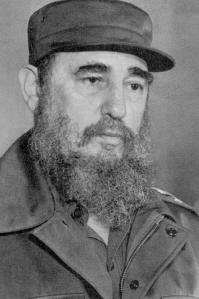 Fidel Castro fashionably sporting the M-1951 Field Cap
Fidel Castro fashionably sporting the M-1951 Field Cap
There was a gap in the Field Cap’s usage in the American Military due to the Vietnam War where it was replaced by a baseball hot weather type of cap and boonie hats. Like most military designs, it made its way back to the troops through the U.S. Army’s new M81 Battle Dress Uniform, famously known as BDUs. The Cap would go through various camouflage patterns, from Woodland to desert types and then eventually the digitalized Army Combat Uniform pattern in 2004.
Within Fashion, the cap has seen the addition of straps, buttons and snaps added to the design. The attractiveness of the Patrol Cap design is its simplicity. It is not quite a baseball cap, but it is uniquely military in its appearance. Many designers and fashion labels also add their own graphic designs to the caps and this allows a certain amount of customization. The original 1943 design is clearly apparent in these designs below.
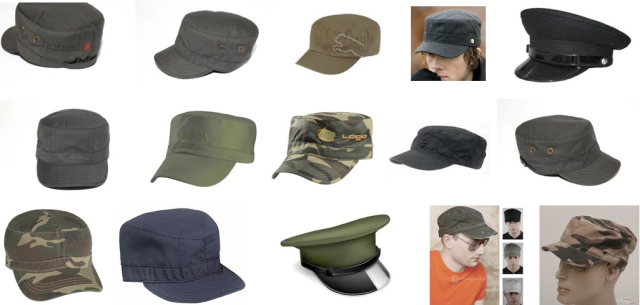 The first page on google with “Military Caps” it is clear how popular the caps are.
The first page on google with “Military Caps” it is clear how popular the caps are.The American military during World War Two began the war like most other countries, with one uniform for all occasions. The same uniform you were expected to meet the president in or get married in was the same uniform you were expected to fight in the muddy trenches with. I cover this ideology further in an earlier post about the M-1941 Parsons Jacket. Having a single uniform that served as a dress and combat uniform required boots that could be just as versatile, the United States’ decided on Russet Brown Low Quarter boots as their boots of choice.
In order for low quarter boots to work well in both ceremony and combat scenarios, an additional piece needed to be added to the boots in order for them to survive in combat. This additional uniform piece was canvas leggings or gaiters, they were added to the low quarter boots at the top and wrapped around a Soldier’s calf in order to extend the height of the low quarter boots and add protection. This was also an economical way for the United States to afford all Soldiers the same protection as full-length boots, without actually outfitting them with expensive leather boots.
Towards the middle of the war around 1943-44, Soldiers actually having a taste of combat from the Pacific to Europe were sick of the long process to put the leggings/low quarter boots on and also the flimsiness of the canvas leggings. The military responded with the new M-1943 Combat Boots. The boots were designed in conjunction with the new M-1943 Uniform, I covered the M-1943 Field Jacket in further detail in an earlier post.
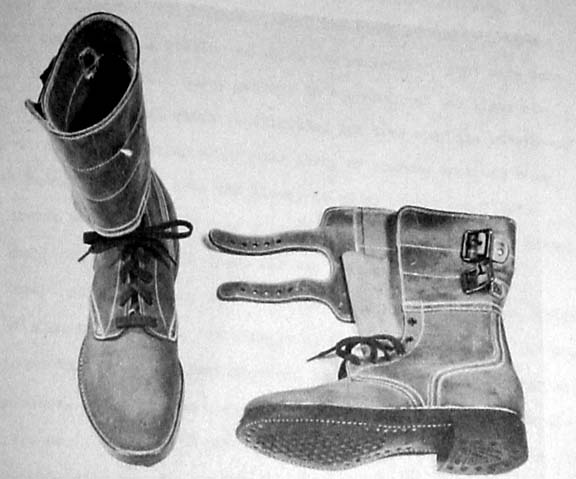 M-1943 Combat Boots (Double Buckle Boots)
M-1943 Combat Boots (Double Buckle Boots)
The new Double Buckle Combat boots were a success! The GIs loved them, they no longer had to spend any extra time lacing up their high canvas leggings, all that was needed to get up and go was a few laces and two large leather buckles. The boots would be worn up until the end of WWII and then onto the Korean War. At the beginning of the Vietnam War American Advisors and South Vietnamese Soldiers did wear the boots and also a canvas and leather jungle version, but by the beginning of major combat operation in Southeast Asia in 1965 the boots were completely phased out.
The M-1943 Combat Boots in WWII
And… now in the 21st century… the Double Buckle boots are back! Women and Men’s shoe designers have created some very stylish boots with the same double buckle that was revolutionary back in 1943. Labels and designers worldwide have taken design aspects directly from the WWII era double buckle boots. The rugged and symmetric look of the double buckles around the ankle area make an excellent design feature that adds a subtle military chic undertone to a variety of boots.
Featured below are some excellent examples of some designer’s takes on the classic double buckle boots.
Balmain Double Buckle Zip up Boots (Green $965.00 & Black $209.00)
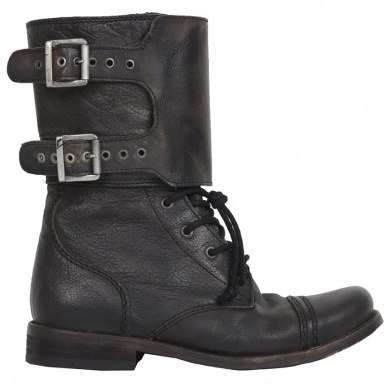 All Saints Damisi Boots $313.78
All Saints Damisi Boots $313.78
The Double Buckle design although shortly lived as a combat boot during WWII and the Korean War, can still be seen today. This is due to some resourceful designers and innovative fashion labels. Like most of my featured pieces there are reproductions being made. Something remarkable about this piece is that the actual reproductions have made their way into the streets as a fashion item to wear. Below are listed the reproduction houses and an example of some repro boots being stylishly worn.
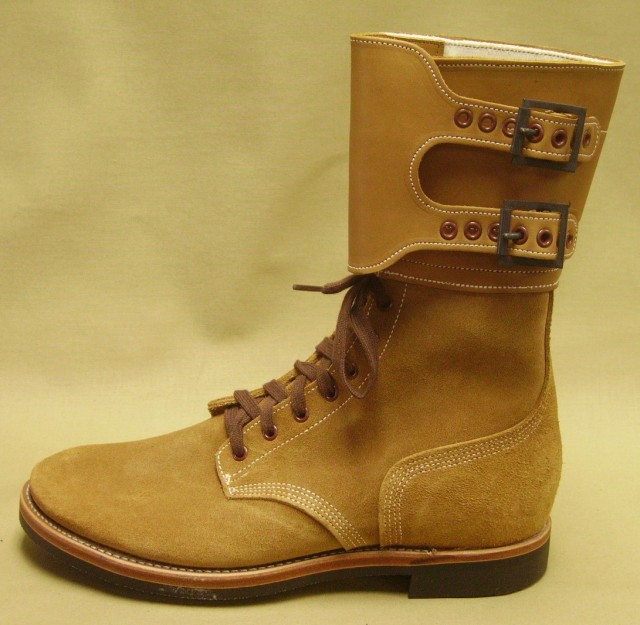 WWII Impressions Double Buckle Boots $185.00
WWII Impressions Double Buckle Boots $185.00
What Price Glory $165.00
Epic Militaria ₤89.95
ZIB Militaria €84.90
At The Front $135.00
The M-1943 Combat Boots (Double Buckle Boots) were the first of their kind, and set the standard for all combat boots in the 20th and 21st century. They would eliminate leggings and gaiters from any modern military and provided Soldiers with boots that they could depend on. Their signature double buckle design would catch the attention of designers and bring some well deserved attention to these classic WWII Boots.
Whether it be marching on to Berlin in 1945 or just going out at night, double buckle boots can take you really anywhere and in style.
…-
The German army during World War Two, was one of the most feared organizations of the time. An element of that fear was its impressive Panzer Tanks, treaded and armored vehicles that rolled over the armies of Europe in 1939-40. The men who commanded these menacing vehicles were highly respected within the German military. Part of their mystique as Panzer commanders and crews, were their all black wool uniforms. These uniforms were highly respected and had a deathly “Totenkopf” or skull insignia, both of which perpetuated the fear surrounding these uniforms.
These were designed to be worn in the tight quarters of a Panzer and also hide any grease marks when working on the vehicles. They were all wool, as many of the uniforms of this time were due to the European climate. The skull insignia and the general design of the uniform, was influenced by the Imperial German Death’s Head Hussar uniforms, another elite unit that fought in World War One. The German military would use these black uniforms until the end of the war. There was a grey version for assault guns, but the majority of the Panzer Crews wore the black version of the uniform.
Here are some examples of the German Panzer Uniforms during WWII.
The infamous Michael Wittmann, one of Germany’s top Panzer Commanders with 138 confirmed tank kills.
It should be noted that there was a slight difference between the German Army Panzer Wraps and the Waffen SS Panzer Wraps, the difference are clear in the photos below. These are examples of the jacket by some reproduction houses.
At The Front’s German Army “Heer” Panzer Wraps above, grey was for Assault Gunners. Assault Guns were not considered Panzers and thus were not authorized the covited black Panzer wraps.
The Wraps above are the Waffen SS versions.
The short tunic style of these jackets with the mixture of a front flap/wrap and button features made them prime pieces for designers to use as inspiration.
Ann Demuelemeester Crossover Jacket Asymmetrical Military Vest
€1000.00 $17.50
All Saints Dresden Jumper
(Left)
(right) June Black Leather Wide Collar Jacket $565.00
As you can see, there are quiet a few of Panzer Wrap influenced fashion pieces. The middle pieces are designed for men. Designers were not the first to look at German Panzer uniforms for inspiration. A young director in the 1970s by name of George Lucas that brought these designs to Hollywood as the uniforms of the quintessential bad guys and Darth Vader’s cohorts, the Empire’s Imperial Officers.
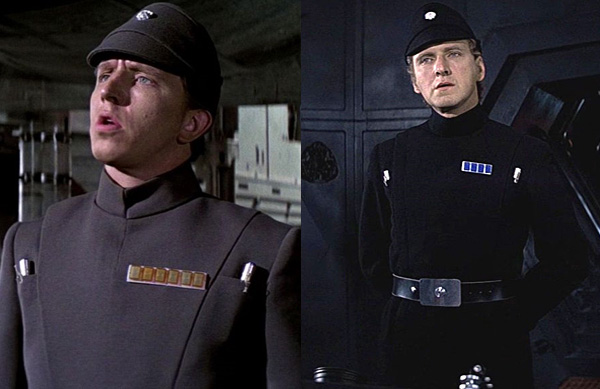 Imperial Officers Star Wars ©Lucalfilm
Imperial Officers Star Wars ©Lucalfilm
Once again German design prevails, it is incredible how much everyday fashion is influenced by military uniforms. I truly believe that in this day and age, where practicality and style walk hand and hand, that military uniforms fulfill this specific need. Military uniforms by their very nature, are designed to be practical and at the same time be aethestically pleasing for the sake of tradition and moral.
Below I have listed some links to some reproduction houses where the reproductions of the originals can be found.
The German Panzer crews and commanders during World War Two considered themselves as an elite and privileged unit and this had a lot to do with their special uniforms. Through modern designers, a bit of this prestige and chic is ultimately transfered to your everyday fashionista. From commanding a Panzer from high atop a tank turret, to walking down 5th Avenue to your local bar, these jackets ensure that any conquest has a little style to it.
…-
Insignia and symbols have always been a cornerstone of military uniforms. It has a lot to do with identification and also moral. In the heat of battle, insignia can say a lot of things for one, who is friendly and who is the enemy, secondly who is in charge lastly, how much experience someone has. Generally speaking these symbols were meant to be clear and concise, but also aesthetically pleasing for moral. One symbol that has transcended through the 20th and 21st centuries, as not only a military symbol, but also a symbol that represents a country and its fashion, is the Royal Air Force Roundel.
 A plane of the Royal Flying Corps over Malta circa WWI
A plane of the Royal Flying Corps over Malta circa WWI
The roundel was created in 1915 during World War One, for the planes of the Royal Flying Corps (the precursor of the Royal Air Force). It was the habit of soldiers in the trenches during the early part of the war, to shoot at anything in the sky, even if they were their own planes. In an attempt to counter this practice, the Royal Flying Corps began to paint Union Flags on the bottom of their wings, unfortunately the flags looked very similar to the Iron Cross symbol that the Germans had on their planes. This led to friendly fire. The British then turned to their French allies and adopted the concept of having the national colors in a circular cockade or roundel. It would be this symbol that would rule the skies over the dreadful fighting in the trenches.
 The symbol would be used for the remainder of the First World War and was dropped during the inter war years because the Royal Flying Corps, begining in 1918 the Royal Air Force, used primarily silver painted airplanes. Then during the 1930’s, the RAF began to use camouflage for their planes again. The symbol was back and this time for good.
The symbol would be used for the remainder of the First World War and was dropped during the inter war years because the Royal Flying Corps, begining in 1918 the Royal Air Force, used primarily silver painted airplanes. Then during the 1930’s, the RAF began to use camouflage for their planes again. The symbol was back and this time for good.
During World War Two, the RAF’s Roundel gained even more popularity as being a symbol of the pilots who saved England from the Blitz and ultimately defeating Nazi Germany. After the war it would continue to be used as a symbol of the RAF and is still in use today.
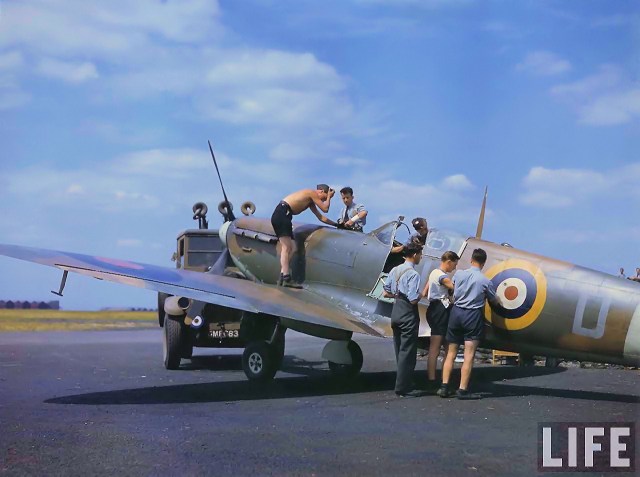 A photo of an RAF Spitfire circa WWII out of LIFE Magazine
A photo of an RAF Spitfire circa WWII out of LIFE Magazine
The Mod fashion wave of the 1960’s introduced the symbol into the fashion world. The band, “The Who” began to wear the roundel and Union Flags during their live shows. It became the symbol of British pop art at the time, especially through the paintings of Jasper Johns. It soon became an iconic symbol of Mods and the Mods Revival. Artists including The Who, The Jam, Ben Harper and Paul Weller, continue to use the roundel in their marketing today.
 Mod Band “The Jam” in Paris, 1980
Mod Band “The Jam” in Paris, 1980
The roundel’s presence in pop art of the 1960’s led to its introduction in fashion. It has made a come back recently through the fashion labels of Ben Sherman and even with the Lambretta scooter company. The Royal Air Force in the last 5 years, has also taken advantage of its popularity and now sells a great deal of merchandise with the symbol on it.
Below I have included just a few fashion items that the Roundel has influnced, but there really is so many that it would be hard to list them all.
Story of the Ben Sherman Label A Ben Sherman T-Shirt
A BBC America Advert using the symbol The band “The Who” T-shirt
The symbol itself has attracted controversy, because the United Kingdom’s Ministery of Defense have sued, in some cases successfully, but in most cases not, to maintain the exclusive rights to the symbol. In response to the popularity of the symbol, the RAF now sells its own clothing line named the “RAF Collection”.
This is a great example of a military symbol, at first only designed to distinguish friend from foe, taking on a life of it’s own through pop culture. The symbol itself has grown far beyond a brand and is now a cherished lovemark of English fashion and culture.
…-